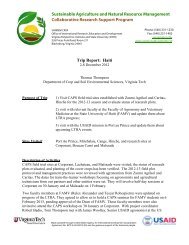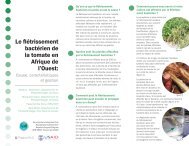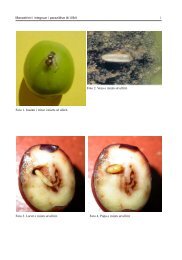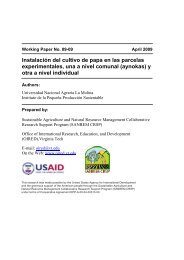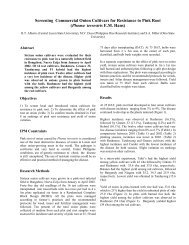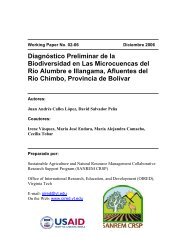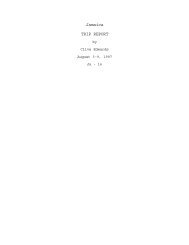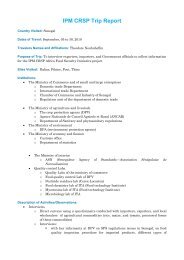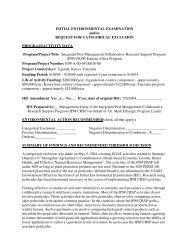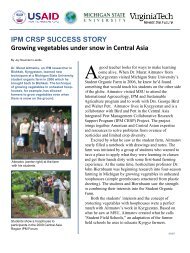Identification Guide - Major Pests of Callaloo - OIRED - Virginia Tech
Identification Guide - Major Pests of Callaloo - OIRED - Virginia Tech
Identification Guide - Major Pests of Callaloo - OIRED - Virginia Tech
You also want an ePaper? Increase the reach of your titles
YUMPU automatically turns print PDFs into web optimized ePapers that Google loves.
<strong>Identification</strong> <strong>Guide</strong><br />
<strong>Major</strong> <strong>Pests</strong> <strong>of</strong> <strong>Callaloo</strong><br />
Contents<br />
Dionne Clarke-Harris 1, Shelby Fleischer 2 and Andrea Fender 1<br />
Introduction ................. 1<br />
Lepidoptera<br />
Fall Armyworm<br />
(Spodoptera frugiperda) .......... 2<br />
Southern Armyworm<br />
(Spodoptera eridania) ........... 4<br />
Beet Armyworm (Spodoptera exigua) .6<br />
Southern Beet Armyworm<br />
(Herpetogramma bipunctalis) ...... 8<br />
Introduction<br />
<strong>Callaloo</strong>, Amaranthus viridis L.<br />
(Amaranthaceae) is an annual herb<br />
grown in Jamaica as a leaf vegetable.<br />
Other common names used in the<br />
Caribbean region are Bhaji, Calalu,<br />
Pigweed, Spinach and White Caterpillar.<br />
The plant grows from 10 centimeters to<br />
about one meter in height under natural<br />
conditions and will grow at middle or<br />
low elevations. Traditionally, callaloo<br />
has been cultivated in Jamaica on small<br />
holdings and backyard gardens for local<br />
markets as a main source <strong>of</strong> iron in the<br />
Jamaican diet.<br />
Over the last 10 years callaloo has<br />
become an important export crop.<br />
Unfortunately, the leaves <strong>of</strong> this plant are<br />
plagued by numerous pest species which<br />
adversely affect yield and marketability<br />
<strong>of</strong> the crop and have required extensive<br />
chemical controls. Chemical control has<br />
1. CARDI, Jamaica 2. IPM CRSP, The Pennsylvania State University, USA<br />
Hawaiian Beet Armyworm<br />
(Spoladea recurvalis) .......... 10<br />
Coleoptera<br />
Banded Cucumber Beetle<br />
(Diabrotica balteata) ........... 12<br />
Flea Beetle (Disonyca laevigata) .... 12<br />
Homoptera<br />
Leafhopper (Empoasca spp.) ...... 13<br />
Acarina<br />
Red Spider Mite (Tetranychus spp.) . 14<br />
References ................. 15<br />
Acsknowledgements .......... 16<br />
<strong>Callaloo</strong> leaves are severely damaged by<br />
foliage feeding insects. The photo above<br />
shows sieve holes and window-pane feeding<br />
patterns <strong>of</strong> some pest species.<br />
been and still is heavily relied upon, but<br />
poses health hazards, insecticide<br />
resistance and environmental contamination.<br />
This guide was developed to<br />
identify the major insect pests <strong>of</strong> callaloo<br />
and to help create an Integrated Pest<br />
Management (IPM) approach that<br />
minimizes reliance on chemical controls.
2 <strong>Major</strong> <strong>Pests</strong> <strong>of</strong> <strong>Callaloo</strong><br />
Fall Armyworm<br />
Spodoptera frugiperda (J.E. Smith)<br />
Order: Lepidoptera (Butterflies and Moths)<br />
Family: Noctuidae (Owlet Moths and Underwings)<br />
Wing span <strong>of</strong> this species is 31-<br />
34mm. The forewings are mottled<br />
greyish-yellow with black, white and<br />
reddish-brown markings, while the<br />
hindwings are white with dark veins<br />
and a fringe <strong>of</strong> dark hairs.<br />
Hindwings <strong>of</strong> adults are lightly<br />
iridescent purple in fresh specimens.<br />
Adults hide in plants during the day<br />
and are attracted to light at night.<br />
Fresh eggs are green and laid in<br />
masses (50-300 eggs) <strong>of</strong> more than<br />
one layer and covered in moth<br />
scales, while older eggs are dark<br />
brown close to time <strong>of</strong> hatching.<br />
Eggs may be laid on upper or lower<br />
leaf surfaces <strong>of</strong> plants, fences and<br />
buildings.<br />
Young larvae are light coloured,<br />
sparsely covered with black setae<br />
and the head capsule is prominent<br />
and dark coloured with an inverted<br />
“Y”. Later larval instars have<br />
blackish lateral stripes and a greyish<br />
or yellowish dorsal stripe which is<br />
twice as wide as lateral stripes with<br />
four black dots on each segment<br />
within the dorsal stripe. They feed<br />
on the upper leaf surface causing<br />
windowing, or leaf tearing. Larvae<br />
migrate to the soil where they<br />
pupate in a tunnel shaped pupal<br />
chamber near the soil surface.<br />
Pupae are 13mm long, dark and<br />
shiny with two minute spines.<br />
Spodoptera<br />
frugiperda larva
<strong>Major</strong> <strong>Pests</strong> <strong>of</strong> <strong>Callaloo</strong> 3<br />
Adult Spodoptera<br />
frugiperda<br />
Typical Spodoptera<br />
frugiperda egg mass<br />
covered with moth<br />
scales.<br />
Pupa <strong>of</strong> Spodoptera<br />
frugiperda with<br />
characteristic<br />
spines at the distal<br />
end.
4 <strong>Major</strong> <strong>Pests</strong> <strong>of</strong> <strong>Callaloo</strong><br />
Southern Armyworm<br />
Spodoptera eridania (Cramer)<br />
Order: Lepidoptera (Butterflies and Moths)<br />
Family: Noctuidae (Owlet Moths and Underwings)<br />
S. eridania moths have a wingspan<br />
<strong>of</strong> about 32mm. Forewings are<br />
greyish-brown and hindwings are<br />
white. Eggs are green and laid in<br />
masses <strong>of</strong> about 200, with each egg<br />
being 0.45mm long, 0.35mm wide<br />
and dome-shaped. The clusters are<br />
covered with moth scales from the<br />
adult female’s abdomen. The head<br />
capsule <strong>of</strong> the larva is a uniform<br />
brown colour. There is a lateral spot<br />
in the first abdominal segment just<br />
above the subspiracular stripe<br />
(common to most S. eridania). The<br />
intensity <strong>of</strong> the subspiracular stripe<br />
fades from the point adjacent to this<br />
spot up towards the head (characteristic<br />
<strong>of</strong> S. eridania). In some individuals<br />
this stripe may be pale or<br />
absent, however the dorsal triangle<br />
on the first abdominal segment is<br />
always relatively large compared to<br />
other dorsal triangles. The maximum<br />
length <strong>of</strong> the final instar larva<br />
is 34mm. Pupation occurs in a pupal<br />
chamber in the soil.
<strong>Major</strong> <strong>Pests</strong> <strong>of</strong> <strong>Callaloo</strong> 5<br />
Late instar <strong>of</strong><br />
Spodoptera<br />
eridania.The<br />
intensity <strong>of</strong> the<br />
subspiracular line<br />
fades from the first<br />
abdominal segments<br />
toward the head.<br />
Adult Spodoptera<br />
eridania
6 <strong>Major</strong> <strong>Pests</strong> <strong>of</strong> <strong>Callaloo</strong><br />
Beet Armyworm<br />
Spodoptera exigua (Hb.)<br />
Order: Lepidoptera (Butterflies and Moths)<br />
Family: Noctuidae (Owlet Moths and Underwings)<br />
The body length <strong>of</strong> adult S. exigua<br />
ranges from 10-14mm with a wing<br />
span <strong>of</strong> 25-30mm. The forewings<br />
are greyish-brown with a small,<br />
round, rust coloured spot above a<br />
smaller kidney-shaped spot. The<br />
hindwings are white with dark brown<br />
veins and margins. Eggs are laid in<br />
masses on the lower leaf surface<br />
and covered with white scales from<br />
the adult female’s abdomen. Larvae<br />
are light green with conspicuous<br />
lateral stripes. They feed on lower<br />
leaf surfaces, leaving the upper<br />
surface intact, though sometimes the<br />
leaves are punctured. The full grown<br />
larva is 30mm with pupation occurring<br />
in the soil. Pupae are 10-14mm<br />
long, brown and shiny.
<strong>Major</strong> <strong>Pests</strong> <strong>of</strong> <strong>Callaloo</strong> 7<br />
Full grown larva <strong>of</strong><br />
Spodoptera exigua.<br />
Adult Spodoptera<br />
exigua.
8 <strong>Major</strong> <strong>Pests</strong> <strong>of</strong> <strong>Callaloo</strong><br />
Southern Beet Armyworm<br />
Herpetogramma bipunctalis (Fabr.)<br />
Order: Lepidoptera (Butterflies and Moths)<br />
Family: Pyralidae (Pyralid, Grass and Wax Moths)<br />
The wings are metallic golden-brown<br />
with black spots, two on the forewing<br />
and one on the hindwing. Dark<br />
brown markings on both wings form<br />
three continuous wavy lines which<br />
are roughly parallel to the wing<br />
margins. The wing span is about<br />
20mm. Eggs are translucent and<br />
nearly colourless, oval shaped sacs<br />
(0.6 x 0.5)mm, laid on the underside<br />
<strong>of</strong> leaves in clusters <strong>of</strong> about ten<br />
eggs. The side attached to the leaf is<br />
flattened. Empty egg sacs are<br />
iridescent and appear as shiny flecks<br />
to the naked eye. Irregular polygonal<br />
reticulations can be seen on the<br />
surface when viewed under X20<br />
magnification. Neonate larvae are<br />
yellow and gradually darken to a<br />
translucent dull green as the larvae<br />
grow. The head is either dark brown<br />
or black and mottled. The cervical<br />
shield has a kidney shaped spot on<br />
either side. The body appears<br />
spotted due to the pigmentation<br />
around the base <strong>of</strong> setae. Fully<br />
grown larvae are 20-23mm long.<br />
Larvae feed on leaves and web<br />
leaves together with a silken thread<br />
to form a protective covering where<br />
they pupate. Pupae are dark brown<br />
and about 10mm long.<br />
Larva <strong>of</strong><br />
Herpetogramma<br />
bipunctalis.<br />
Prepupal stage<br />
turns yellowish<br />
cream, and spots<br />
are prominent.
<strong>Major</strong> <strong>Pests</strong> <strong>of</strong> <strong>Callaloo</strong> 9<br />
Late instar <strong>of</strong><br />
Herpetogramma<br />
bipunctalis webs<br />
leaf around itself.<br />
Adult<br />
Herpetogramma<br />
bipunctalis<br />
Left: Cluster <strong>of</strong><br />
translucent<br />
Herpetogramma<br />
bipunctalis eggs laid<br />
on underside <strong>of</strong> leaf.<br />
Right: Empty egg sacs
10 <strong>Major</strong> <strong>Pests</strong> <strong>of</strong> <strong>Callaloo</strong><br />
Hawaiian Beet Armyworm<br />
Spoladea recurvalis (F.)<br />
Order: Lepidoptera (Butterflies and Moths)<br />
Family: Pyralidae (Pyralid, Grass and Wax Moths)<br />
The adult is a dark brown moth with<br />
two white translucent bands on the<br />
forewings and one on the hindwings;<br />
these bands form a continuous arch<br />
pattern when the wings are spread.<br />
The wing span is about 20mm. The<br />
eggs are scale-like, shiny translucent<br />
yellow sacs, 0.6 x 0.5mm. The<br />
larvae are a translucent green with<br />
the gut visible through the integument<br />
as a pulsating dark green band.<br />
There are two longitudinal white<br />
wavy lines sandwiching the green<br />
band formed by the gut. The head<br />
capsule is light coloured. In the<br />
prepupal stage the larva changes<br />
colour from green to yellow to brown<br />
to bright pink. The larva webs the<br />
leaf around itself using silken<br />
threads and pupates there. Pupae<br />
are 8-10mm long and straw<br />
coloured.<br />
Middle instar larva <strong>of</strong><br />
Spoladea recurvalis
<strong>Major</strong> <strong>Pests</strong> <strong>of</strong> <strong>Callaloo</strong> 11<br />
Adult Spoladea<br />
recurvalis<br />
Egg cluster <strong>of</strong><br />
Spoladea recurvalis<br />
attached to the<br />
underside <strong>of</strong> leaf.
12 <strong>Major</strong> <strong>Pests</strong> <strong>of</strong> <strong>Callaloo</strong><br />
Banded Cucumber Beetle<br />
Diabrotica balteata LeC.<br />
Order: Coleoptera (Beetles)<br />
Family: Chrysomelidae (Leaf Beetle)<br />
The adult beetle is 6mm long with a<br />
reddish-brown head, dark eyes and<br />
long antennae. The body is greenish<br />
with yellow bands. Eggs are laid in the<br />
top 10cm <strong>of</strong> soil near the base <strong>of</strong> the<br />
host plant. These beetles gnaw holes<br />
in the leaves. Larvae are whitish and<br />
wireworm-like and feed on roots.<br />
Pupation takes place in soil.<br />
Flea Beetle<br />
Disonyca laevigata (Jacoby)<br />
Order: Coleoptera (Beetles)<br />
Family: Chrysomelidae (Leaf Beetle)<br />
These beetles are 7-8mm long. Their<br />
elytra are striped with alternating dark<br />
brown and yellow bands. The head,<br />
thorax, abdomen and legs are redorange<br />
in colour. The femur <strong>of</strong> the<br />
hind legs are enlarged because these<br />
beetles are strong jumpers. They<br />
Adult Diabrotica<br />
balteata<br />
gnaw holes in the leaves. Eggs are<br />
ellipsoidal with one end more pointed<br />
than the other and are scattered in soil<br />
near the base <strong>of</strong> host plants. Larvae<br />
are wireworm-like with a whitishbrown<br />
head. They feed on roots and<br />
pupate in soil.<br />
Left:<br />
Adult Disonyca<br />
laevigata<br />
Right:<br />
Adult Disonyca<br />
laevigata (color<br />
variation) on<br />
damaged leaf
<strong>Major</strong> <strong>Pests</strong> <strong>of</strong> <strong>Callaloo</strong> 13<br />
Leafhopper<br />
Empoasca spp.<br />
Order: Homoptera (Aphids, Leafhoppers, Planthoppers, Scale insects and Allies)<br />
Family: Cicadellidae (Leafhoppers)<br />
Adult leafhoppers are about 3mm<br />
long, slender bodied and shiny green<br />
in colour. Eggs are oviposited in<br />
stems or leaf ribs. Nymphs are<br />
bright green and feed on the underside<br />
<strong>of</strong> the leaf where they run<br />
about. Adults and nymphs feed by<br />
piercing plant tissue with slender<br />
needle-like mouthparts and removing<br />
plant juices. Linear yellow<br />
etchings on the leaf surface result<br />
from feeding, and a very heavy<br />
infestation affects the health, vigor<br />
and aesthetics <strong>of</strong> the crop.<br />
Left:<br />
Adult Empoasca and<br />
damage symptoms<br />
caused by feeding.<br />
Right:<br />
Magnification<br />
Left:<br />
Nymphs <strong>of</strong><br />
Empoasca on<br />
underside <strong>of</strong> leaf.<br />
Right:<br />
Magnification
14 <strong>Major</strong> <strong>Pests</strong> <strong>of</strong> <strong>Callaloo</strong><br />
Red Spider Mite<br />
Tetranychus spp.<br />
Order: Acarina (Arachnids)<br />
Family: Tetranychidae (Spider Mites)<br />
Adult mites are 0.3-0.4mm and<br />
globular. They are a dull red colour,<br />
eight-legged, with an oval body<br />
sparsely covered with spines. Two<br />
dark spots show through the transparent<br />
body wall. The mites feed on<br />
the lower surface <strong>of</strong> the leaves<br />
causing yellowing and speckling. A<br />
heavy infestation causes silvering <strong>of</strong><br />
the leaf, ‘silver back’ and ultimately<br />
leaf abscission. The nymphs are<br />
similar to adults but have only six<br />
legs. Eggs are spherical, translucent<br />
and laid on the underside <strong>of</strong> leaves<br />
attached to the leaf surface by a web<br />
spun by the mite. All stages <strong>of</strong> the<br />
mite can be found on a single leaf<br />
where they form a colony.<br />
Tetranychus egg and<br />
adult stage<br />
Tetranychus colony<br />
on underside <strong>of</strong> leaf.
<strong>Major</strong> <strong>Pests</strong> <strong>of</strong> <strong>Callaloo</strong> 15<br />
References<br />
Fennah, R. G. 1947. The Insect <strong>Pests</strong> <strong>of</strong><br />
Food Crops in the Lesser Antilies.<br />
Dept. <strong>of</strong> Agriculture for the Windward<br />
Islands, St. George’s, Grenada, British<br />
West Indies: Department <strong>of</strong> Agriculture<br />
for the Leeward Islands, St.<br />
John’s, Antigua, British West Indies.<br />
207 pp.<br />
Gowdey, C.D. 1923. The Principal<br />
Agricultural <strong>Pests</strong> <strong>of</strong> Jamaica. Govt.<br />
Print. Office. Kingston, Jamaica. 86<br />
pp.<br />
Kranz, J., K. Schmutterer and W. Koch<br />
(eds.) 1978. Diseases, <strong>Pests</strong> and<br />
Weeds in Tropical Crops. John Wiley,<br />
Inc. Chichester, New York. 666 pp.<br />
Krysan, J. L. and T.A. Miller (eds.)<br />
1986. Methods for the Study <strong>of</strong> Pest<br />
Diabrotica. Springer-Verlag, Inc.<br />
New York. 260 pp.<br />
Metcalf. C.L. and W.P. Flint (eds.) 1939.<br />
Destructive and Useful Insects and<br />
Their Habits and Control. McGraw-<br />
Hill Book Company. New York. 981<br />
pp.<br />
Passoa, S. 1991. Color identification <strong>of</strong><br />
economically important Spodoptera<br />
larvae in Honduras (Lepidoptera:<br />
Noctuidae). Insecta Mundi. Vol. 5(3-<br />
4):185 - 192.<br />
Peterson, A. 1962. Larvae <strong>of</strong> Insects.<br />
Edwards Brothers, Inc. Ann Arbor,<br />
Michigan. 732 pp.<br />
Peterson, A. 1963. Egg types among<br />
moths <strong>of</strong> the Pyralidae and<br />
Phycitidae-Lepidoptera. The Florida<br />
Entomologist. Supplement No. 1<br />
(September). 14 pp.<br />
Schmutterer, H. 1990. Crop <strong>Pests</strong> in the<br />
Caribbean with Particular Reference to<br />
the Dominican Republic. Eschborn,<br />
Germany. 640 pp.<br />
Sorensen, K.A. and J.R. Baker (eds.).<br />
1994. Insect and Related <strong>Pests</strong> <strong>of</strong><br />
Vegetables, AG-136, N.C. Ag. Ext.<br />
Serv. Dept. <strong>of</strong> Agricultural Communications,<br />
North Carolina State<br />
University. Raleigh, NC. 180 pp.<br />
Stoetzel, M. 1989. Common Names <strong>of</strong><br />
Insects and Related Organisms.<br />
Entomological Society <strong>of</strong> America.<br />
Landam, MD. 199 pp.
16 <strong>Major</strong> <strong>Pests</strong> <strong>of</strong> <strong>Callaloo</strong><br />
Acknowledgements<br />
The authors would like to acknowledge<br />
the assistance <strong>of</strong> Dr. Steven<br />
Passoa (US APHIS) and Dr. Bruce<br />
McPheron (The Pennsylvania State<br />
University) for their help in the<br />
identification <strong>of</strong> larval specimens,<br />
and Mr. Anthony Trought for conducting<br />
confirmatory laboratory<br />
studies on the Pyralid species. We<br />
would also like to recognise Mr. M.<br />
Alam and Mr. Phillip Chung who did<br />
some <strong>of</strong> the photography.<br />
We would also like to thank Mary<br />
Wodecki-Ricard (PSU) for her work in<br />
completing this project, and Dr.<br />
Charles Pitts (PSU) for essential<br />
advice and encouragement.<br />
Support for this publication was<br />
provided by the Caribbean Agricul-<br />
Published by<br />
The Pennsylvania State University<br />
1998<br />
tural Research and Development<br />
Institute (CARDI) and Integrated Pest<br />
Management Collaborative Support<br />
Program (IPM CRSP). The IPM CRSP<br />
is an initiative <strong>of</strong> the United States<br />
Agency for International Development<br />
(USAID).<br />
This publication was made possible<br />
through support provided by the<br />
United States Agency for International<br />
Development (USAID) under<br />
terms <strong>of</strong> Grant No. LAG-G-00-93-<br />
0053-00 made to <strong>Virginia</strong> Polytechnic<br />
Institute and State University<br />
(<strong>Virginia</strong> <strong>Tech</strong>).<br />
The opinions expressed herein are<br />
those <strong>of</strong> CARDI and IPM CRSP and<br />
do not necessarily reflect the views<br />
<strong>of</strong> the USAID.



